Backpacking in India and Nepal
Chaotic cities and green landscapes
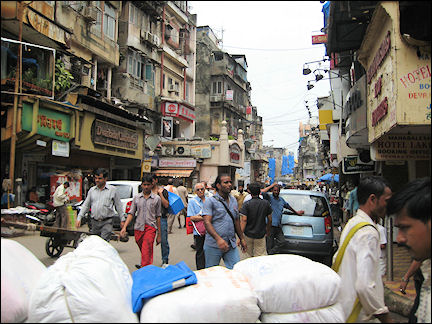
|
Delhi looks like a big, chaotic garbage dump where holy cows block traffic. Via Bikaner (rat temple and camel trip), Jodhpur (fort on a cliff), Jaipur (Amber Fort) and Agra (Taj Mahal) in Rajasthan to colorful Varanasi on the holy Ganges river. Bungee jumping, rafting and paragliding in Nepal, in the surroundings of Kathmandu and Pokhara. Back in India via the jungle of Goa with its beautiful beach to Mumbai, where the streets display enormous poverty.
Travelogue & photos: Johan Mühren
Even before the flight attendant asks if we want coffee or tea, we have changed our travel plans already five times. We are on our way to India, open-minded and all but unprepared, to travel around for 32 days with the backpackers bible Lonely Planet as our only guide.
Delhi
Car exhaust, moped noise and one big garbage dump
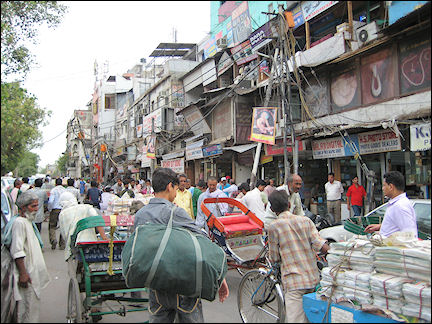
|
Delhi is another name for chaos. But the culture shock that we were told would await us, doesn't take place. The polluted air and traffic are comparable with Bangkok, Thailand and the moped terror and noise are much like that in Vietnamese cities like Hanoi and Saigon.
Still Delhi is quite another story. It's the most chaotic, crowded and filthy city I have ever visited. This city (and all other cities we visit in India) is one big garbage dump. Trashcans are rare and it's considered normal to leave garbage in the streets. The few trashcans are apparently never emptied.
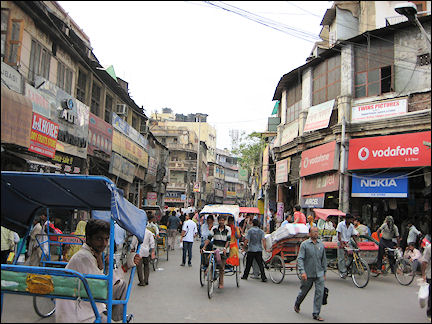
|
And then there's the heat. It feels as if you're in a sauna all day long, and the shade is no more effective than moving to a lower bench in the sauna. It goes without saying that we sweat a lot and in unexpected parts of our bodies.
Cows, holy animals in India, are happy to use the overcrowded cities as their territory. Traffic jams because of crossing cows are therefore more rule than exception. Cows frequently lie down in the middle of the road, and the most chaotic traffic in the world has to manoeuvre around them.
Cows have the company of other animals in the city: donkeys, pigs, dogs, cats, chickens, goats, rats, camels and elephants, which usually also roam the streets freely.
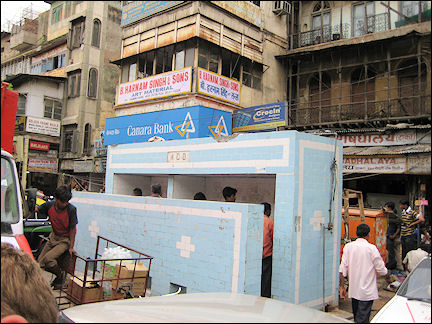
|
Add to this speeding and honking cars and buses, polluted trucks, fragile rickshaws, weaving mopeds and people with way too heavy loads on their backs and you have an impression of Indian street life.
Soot filters probably aren't default on cars, buses or trucks in India. The pitch-black dust clouds are too filthy for words and the amount of smog becomes clear when a bright white towel turns greyish when I dry myself after a badly needed shower in the evening.
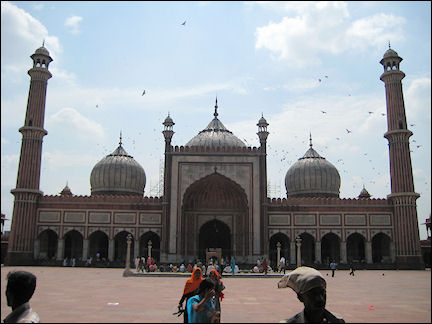
|
After some cultural sights, like the stunningly beautiful Jama Mashid mosque, the Red Fort and the Qutab Minar tower, the highlight is the bazar in Old Delhi. The narrow, stuffy streets are filled with incredibly hectic Indian activiy.
There are also rickshaws, scooters and too wide carts in those narrow streets, causing traffic jams and a delightful mess.
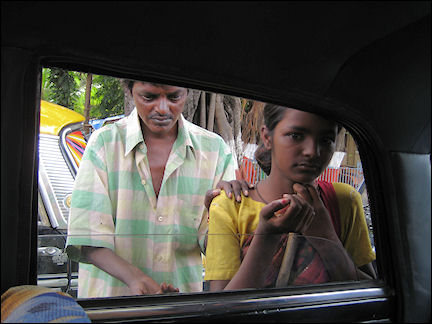
|
Don't underestimate poverty in India. Most people are extremely poor and many beg. The sickest image in Delhi was a man with open wounds on his head and legs with hundreds of flies on them; the poor man rolled back and forth in the burning sun, screaming for Allah.
Rajasthan
Bikaner, Jodhpur, Jaipur and Agra
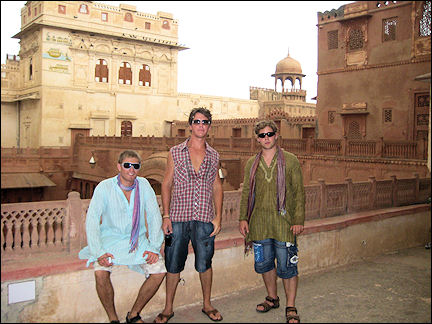
|
Because of the approaching monsoon season, we first visit the province of Rajasthan, to the west of Delhi, to avoid the rain. We find a private chauffeur who will drive us through Rajasthan for ten days, at a very moderate price.
We soon find out that roads in India are something else. Sometimes there is only one lane and if there is oncoming traffic, one of the two will have to yield. But neither party wants to give in too quickly, so three or four times our chauffeur has to swerve at the very last moment to prevent a frontal collision.
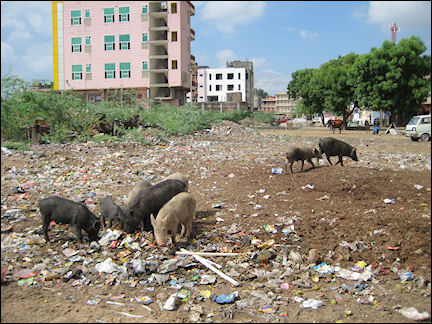
|
After a night in Mandawa - the most boring place we visit - we leave for Bikaner. Bikaner also is a huge, filthy, chaotic, and polluted city. While we visit a fort, we are surprised by torrential rains. We decide to let our driver take us back to the hotel.
Because the sewer system either doesn't function or doesn't exist, the water stays at the surface. That means we can't take the car, because the city is flooded.
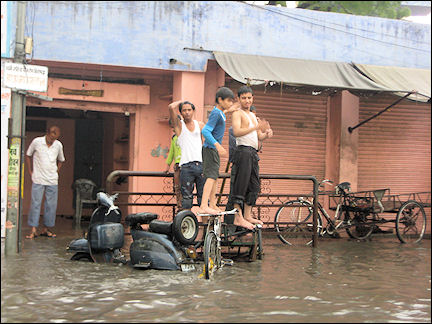
|
We already smell a rat and ask what to do next. "You have to walk," the driver says with a fake-innocent smile. And he is right: there is no other way. We walk up to our waists in brown mud, filth and excrement.
It's tricky: we can't see the ground, so we are taken by surprise every now and then by holes or obstacles.
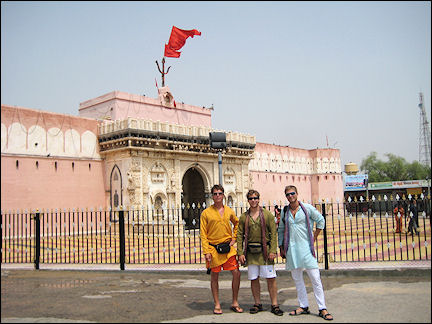
|
Around us, Indians dance and swim in their underwear because the monsoon has finally begun. It's wonderful to see their heartfelt happiness.
Near Bikaner is the Karni Mata (rat temple). Yes, indeed: rats are worshipped there. There are hundreds, maybe thousands of rats, half of which are dead and rotting. The smell is terrible and I dont' think their shit is ever cleaned up. The living rats are doing their own thing and are around you everywhere.
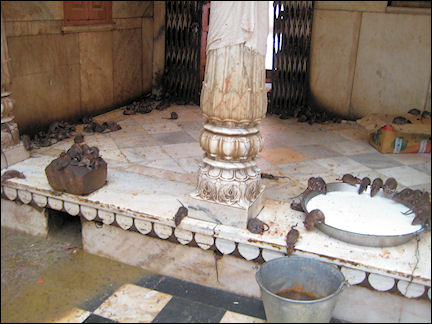
|
When I lose a bet, I have to lie down amidst the rats. Kees is sympathetic and joins me on maybe the filthiest place on earth.
After our visit to this bizarre temple, we take a camel trip in the desert. It's not the kind of desert I had imagined: it's relatively green. The camel trip lasts a bit too long, making me fear I will remain bow-legged forever.
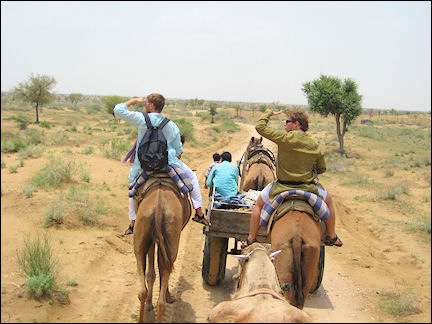
|
Fortunately my legs straighten out after a while. We sit cosily around a self-made campfire. We spend the night in the open air in the desert. Too bad the overcast sky obstructs the view of the stars.
The next city we visit is Jodhpur ("Sun City"). This is a surprise on our tour of Rajasthan. The fort on a cliff is impressive. We won't forget the climb up there any time soon, but it was definitely worth it.
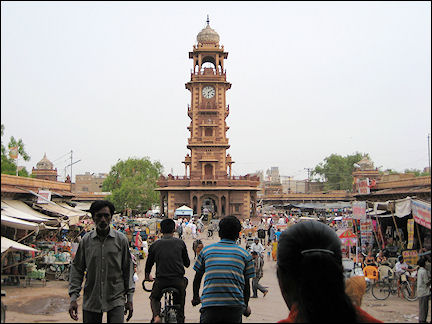
|
Jodhpur's inner city is picturesque and the atmosphere is relaxed. A beautiful, English-style clock tower marks the city center. The atmosphere gets a lot less relaxed when we skip the Indian food and want to "sin" at a MacDonalds.
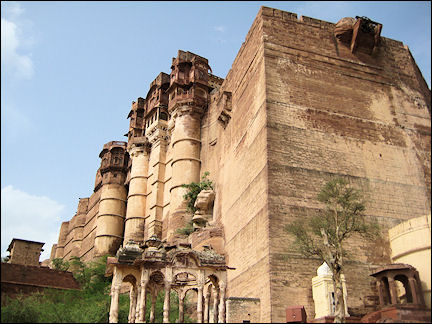
|
We are searched three times with all kinds of electronic gadgets; the macho guys with big guns aren't smiling either. It turns out that there is a serious terror threat that day in Jodhpur.
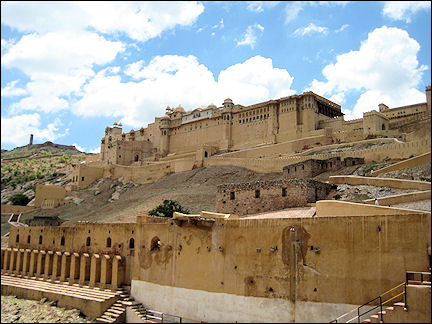
|
Via Puskhar we travel to Jaipur, the capital of Rajasthan. Even though it's called "pink city" I think it looks more orange or chestnut. Except for the Amber fort, I am not impressed with Jaipur. Probably I'm already preoccupied with our next visit, to Agra in Uttar Pradesh.
Agra has the Taj Mahal, one of the new seven wonders of the world. The completely symmetrical building is made of white marble and richly decorated with inlaid stones. Even though I've seen pictures of it, I'm overwhelmed by the beauty of this breathtaking structure.
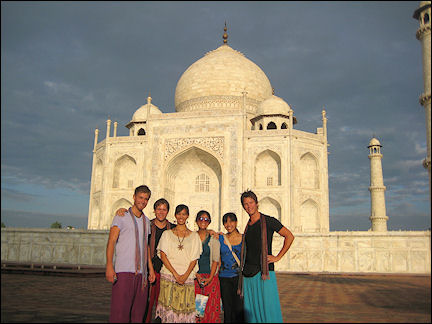
|
We see the Taj at sunrise; the building changes color every hour because of the trajectory of the sun. Nice factoid: the four minarets on the corners are slightly bent, so they won't collapse onto the building in case of an earthquake, but away from it.
After wandering around the Taj Mahal for a couple of hours, we find that Agra doesn't have much else to offer, so we decide to take the night train to Varanasi. This city is also in Uttar Pradesh, which means "Northern Province".
Varanasi
A lugubrous but also atmospheric and colorful city
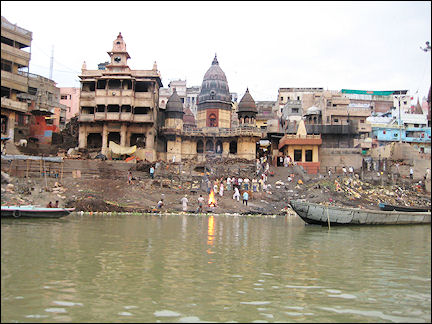
|
Varanasi is the holiest place of India. Every day hundreds of dead Hindus are cremated in this city before their remains are thrown in the Ganges river. The burning of the corpses is quite a sight.
First, wood is gathered and the dead body is laid out between layers of wood. Then the oldest son walks five times around the funeral pyre and lights the fire.
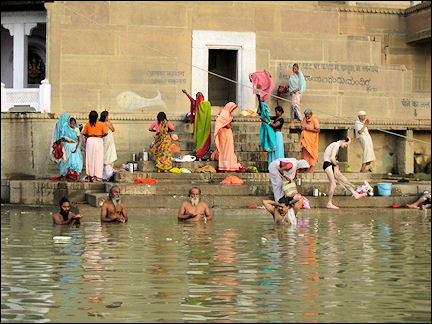
|
After two to three hours the bodies are for the most part burned and what remains (the torso or other bones) is thrown in the Ganges. Where the bones and ashes reach the river, a man stands up to his waist in the water with a sieve, to retrieve gold and silver from the bodies' teeth.
The bodies of women who died while pregnant and those of children and the sick are thrown in the Ganges as they are, unburned. They are made heavier, but at some point they come up again, which makes for surrealist images.
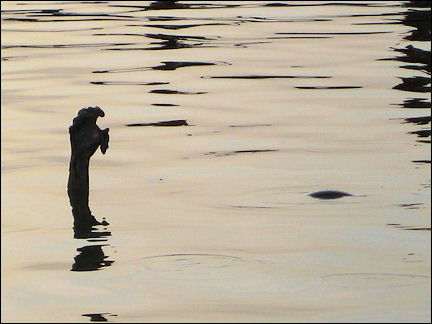
|
When we are sailing on the Ganges in a little boat, we see a hand on its surface. At first we think we are imagining it because of sleep deprivation. But when we get nearer, there is only one conclusion possible: it's a hand of a body that has been thrown in the river. Mildly shocked, we take pictures of this fascinating scene.
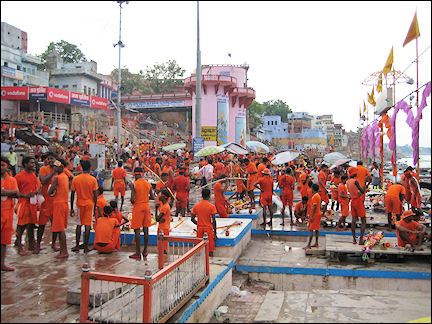
|
Apart from it lugubrity, Varanasi is actually a colorful and atmospheric city. Next to the funeral pyres women and men are washing their clothes in the Ganges, hundreds of people are swimming in the river and water is purified for drinking.
The pollution of the Ganges is bewildering, though: rivers should have no more than five hundred fecal bacteria per hundred milliliters to make it safe for bathing, but the Ganges has over 1.5 million. The water doesn't contain oxygen at all.
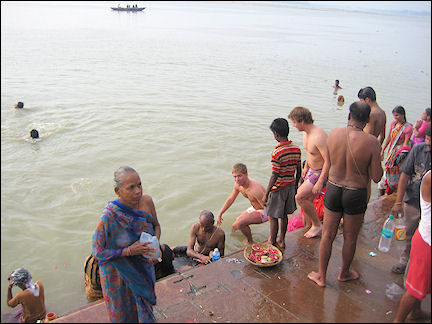
|
Of course we also want to wash away our sins. With bare upper bodies and towels around our necks - as if we're on the beach - we resolutely walk toward the Ganges to take a "refreshing" bath. It's clear that this doesn't happen too often: everyone is staring at us.
The water feels actually nice and of course our heads need to be submerged, too. You just have to ignore the ashes floating around you. Two days later Ger and Kees lie vomiting in the bathroom, but of course we won't ascribe that to our plunge.
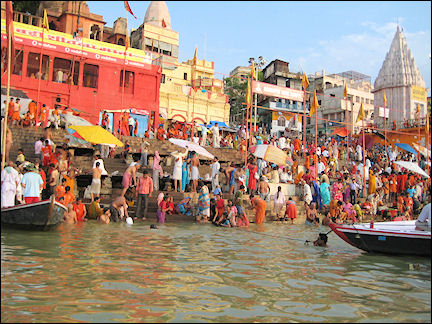
|
Every day there's a power outage that lasts for a couple of hours. I am secretely having fun when after one and a half hours of typing an e-mail message, Ger moves his cursor to "send" and immediately the power is out, so he has to begin all over again.
We think Varanasi is the most special, extraordinary place we visited in India. It's fascinating to see the inspiration of thousands of bathing and playing Hindus. To get away from the crowds, filth, heat, craziness, chaos and lack of cozy cafés, we decide to visit Kathmandu in Nepal.
Nepal
Rafting, bungeejumping and paragliding
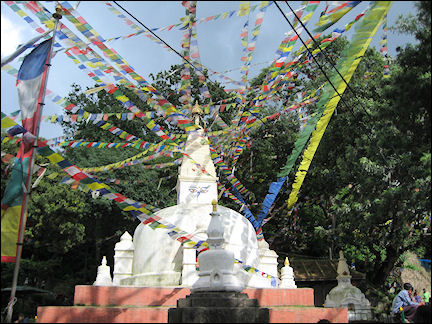
|
The atmosphere is more relaxed in Nepal than it is in India; people are also sincerely nice. The temperature is more pleasant and it's a lot cleaner, too. But don't get excited: we meet a girl who is leaving because she thinks Kathmandu is a filthy city. But she didn't travel in India...
We are happy to be able to drink a beer in a bar in the Thamel district. In India there was no opportunity. After a few quiet days in Kathmandu it's time for some adventure.
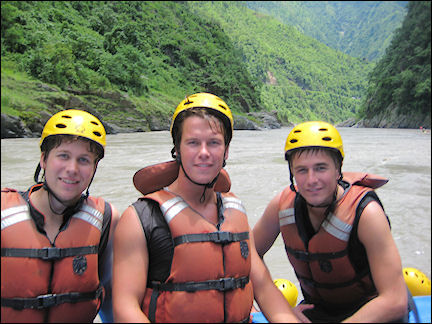
|
We book a rafting trip for two days and go bungeejumping. The raft trip is a little disappointing, because the river isn't wild enough for real action, despite its rapids.
Our next shot of adrenaline is bungeejumping from a rickety and wobbly 160 meters high bridge. Below us is an extremely agressive river, so if the rope breaks, you can have yourself transported to Varanasi to be thrown in the Ganges.
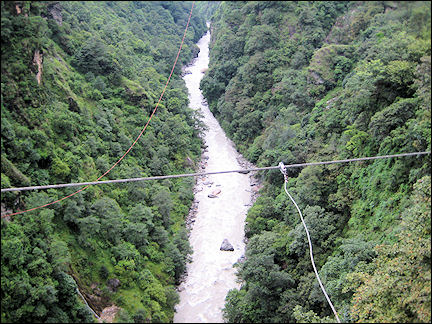
|
Because we are in the second group, we have to wait for two hours before we can jump. To kill time, we do the "swing": you jump straight ahead and then are in free fall for 120 meters, after which you swing sideways to the next bridge.
I jump with positive tension, my life literally hanging by a thread. Because fear kills common sense, it's better not to think about this. I am really happy to have made this jump, because the sensation during the jump is the best kick you can have.
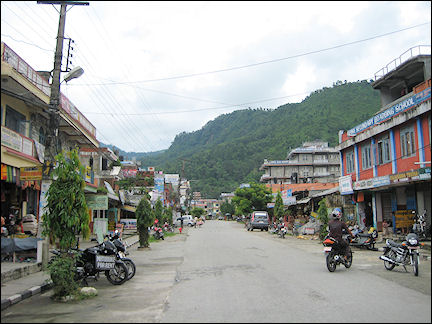
|
Before we leave for Pokhara, Ger tells us he doesn't have the strength to return to filthy, chaotic and hot India after our visit to Pokhara, so he leaves us prematurely. Too bad, because Ger is a great traveling companion. The proverb "India: you love it or you hate it" is definitely applicable here.
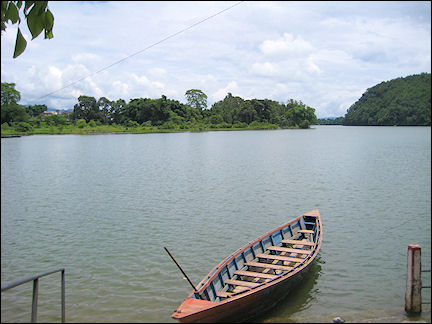
|
Our trip by car from Kathmandu to Pokhara lasts five hours longer because of a landslide: after 12 hours of traveling we arrive exhausted. Pokhara is the exact opposite of Indian cities: relatively clean, super-relaxed, the temperature is pleasant and there are nice bars to sit down and relax.
Its touristic part is one long shopping street with at the end a picturesque lake. After a few days of rest on and around the lake, Kees and I are ready for some action.
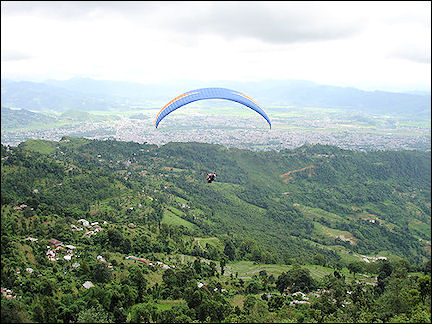
|
We book a paragliding flight. The idea is to run very fast down a mountainside with a parachute on your back, which should make you glide at some point. When you do, you hover in the air with views of the lake and the mountain passes behind it for half an hour. It's an indescribable sensation.
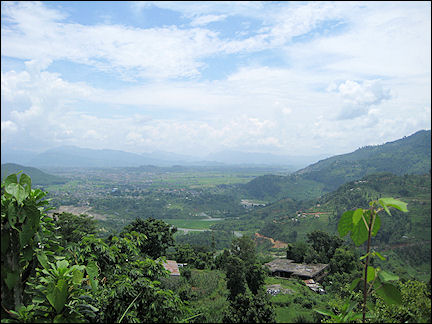
|
During our last two days in Pokhara we explore the surroundings by scooter. After hours of touring in the mountains, we have a good impression of Nepal's beautiful landscape. Nepal is mountainous, there are hardly any level parts.
Goa
Jungle with beautiful beaches
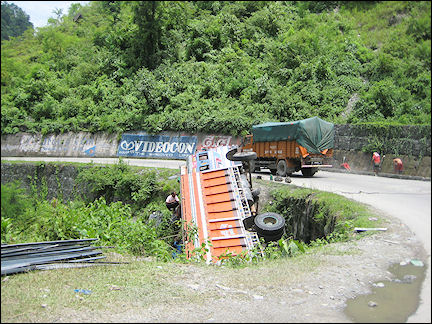
|
After 12 days in Nepal we travel to the former hippie stronghold of Goa on the west coast of India. There are no direct flights from Pokhara, so we have to return to Kathmandu. On the bus we manage to get wonderful - but illegal - seats on the roof.
The views are great and the wind is our airconditioning. We try to forget that we already saw two or three buses in ravines.
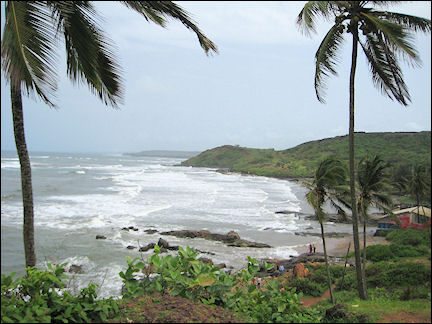
|
Goa, often called a paradise on earth, is mostly jungle, surrounded by great beaches. The beaches are somewhat neglected after the tourist season, but the hippie atmosphere can still be felt.
We visit several beaches on the Arabian Sea by scooter. It's forbidden to take a swim, because of the strong currents, but Kees and I can't help ourselves: we have to test the current.
On the way we are stopped by the police because we're not wearing helmets. We give the excuse that we thought it was only obligatory for motor bikers and not for scooters. We succeed in reducing the 20 euro fine to two euro - under the table. We call this positive corruption.
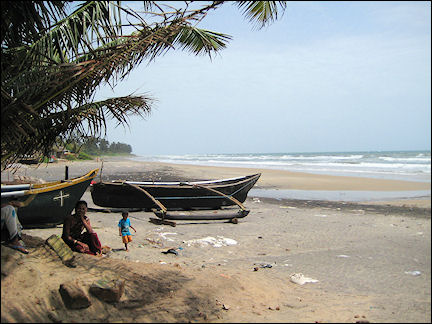
|
In the evening we watch movies with a handful of backpackers and die-hard hippies, while enjoying alcoholic beverages. We are at a one and a half hours distance from our hotel, so it's best to spend the night here.
Kees books a hotelroom for 1.50 euro a night. Initially the room looks good, but I wake up itching at 3 am. When Kees also wakes up and itches everywhere, only one conclusion is possible: flees! What do you want for this amount.
AFter a few days of rest in Goa we leave for Poona in the province of Maharashtra. The Osho Ashram, a meditation center, is located there. When we are deceived by two moustachioed guys who have transported us in a rickshaw and charge us a ridiculous amount, it almost gets to punches.
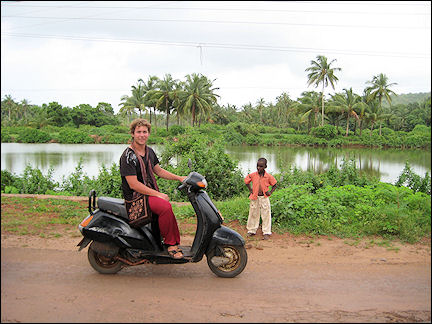
|
After some pushing and pulling, in which we state not to be prepared to pay more than the regular price, it gets dicey, and an (Indian) crowd gathers around us. Kees has reached his boiling point, it's only a matter of time and he'll explode.
The moustachioed guys propose to go to the police to find a way out, but because of the - in this case: negative - corruption, we don't think that is a great idea.
The situation gets dire when one of the guys picks up a rock to beat Kees with. To prevent further escalation, I compromise and give them most of the amount they asked for. Angry and frustrated we leave for the meditation center; at least we now have a good reason to be there.
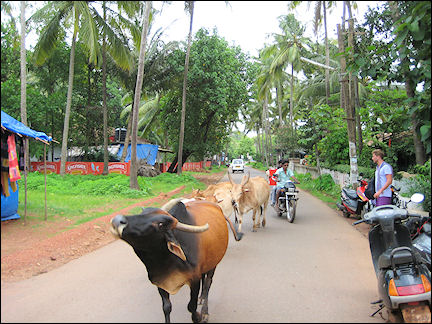
|
The Osho Ashram was founded by the now departed Bhagwan Sri Rajneesh, aka Osho. He predicted that two-thirds of the world population would die of AIDS. Because of this, he didn't want HIV-infected people on his campus: you have to get tested before you can enter.
The one and a half days we spend in the meditation center are the oddest of my life. In the introduction group we have to talk to other people while wearing masks, because it only matters who you are and not what you look like. Afterwards everyone has to do a traditional dance and because Kees and I are from Europe, we have to waltz.
During our first meditation we first have to breath in and out forcefully through our noses to generate as much energy as possible. After ten minutes a gong is sounded and we have to vent all our anger, stomping with our feet and hands and screaming. After this we have to hop with our hands in the air and make "oo" sounds every time we touch the floor. The meditation is concluded by lying on the floor completely still.
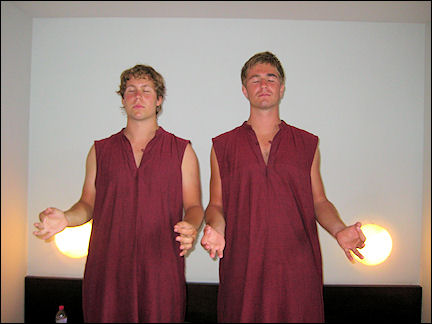
|
During another meditation we have to sit still for half and hour: Kees falls asleep. There is a variety of meditations, in which you have to find chakras, or express all your emotions and more weird stuff.
The most fun event is the evening meeting. There are over a hundred people, all dressed in white garments, dancing to the stirring music of a band. They are completely enthralled. When the music stops, all hands go in the air and everyone yells "Osho".
After half an hour the gong sounds again and we have to listen in complete silence to an Osho video for twenty minutes. He says that the individual is more important than anything else and more of those New Age one liners. When Osho is finished we have to speak a non-existing language for five minutes and then drop dead on the floor. At the end we have to go crazy with the music again.
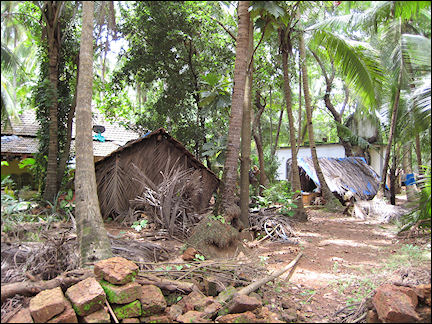
|
Kees and I, both rather laid back in nature, reach the conclusion that there is nothing for us here and we bolt.
Mumbai
People are literally dying in the streets
We try to get a room in the infamous Taj Mahal hotel. We expect that the room rates have gone down after the terror attacks, but that is not the case. The cheapest room is 300 euro a night, so we find another hotel in the neighborhood.
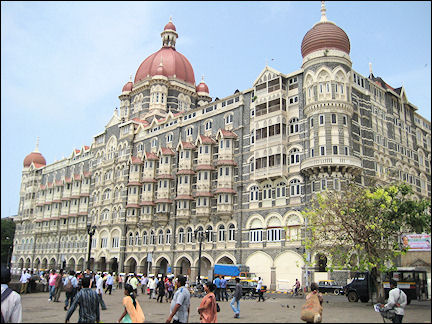
|
Mumbai looks like Delhi but has more open spaces and more greenery; the English influence is much clearer here in the architecture.
India's film industry is in Mumbai, so we watch a Bollywood film. People in the movie theater go crazy when they hear one of those famous rythmic Indian songs, but are very quiet during the romantic feel-good movie "Love Aaj Kal".
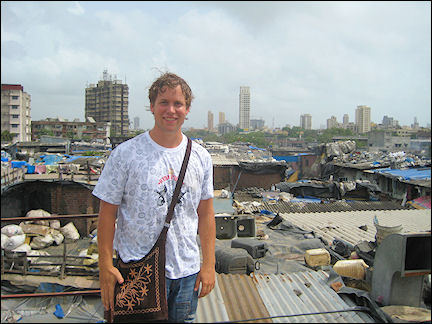
|
When we walk outside late at night, which is supposed to be risky, we have to step over dozens of homeless adults, children and half-naked babies: they are all sleeping on the streets. Even though I am usually able to close off my feelings, I swallow a few times. People are literally dying in the streets here.
On our last day we take a slum tour to get a more complete impression of India. It's really sad to see how these people live. Everyone who lives in a western country should be forced to visit India to see what it's like. That would greatly reduce the whining about trivial "problems".
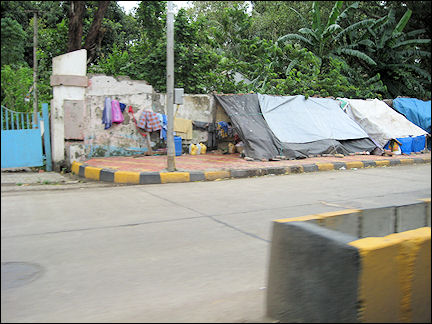
|
Our adventurous trip is already over. India is a fascinating country. It drains your energy because of everything that happens around you, one thing even more astonishing than the other.
India is of course more than the hectic life: the stunningly beautiful Taj Mahal and countless beautiful palaces and forts. It's possible to have a relaxed and less chaotic vacation if you travel to Goa or other places in the south. But I am glad that I have had all these experiences: stranger than this I won't see anytime soon, unfortunately.